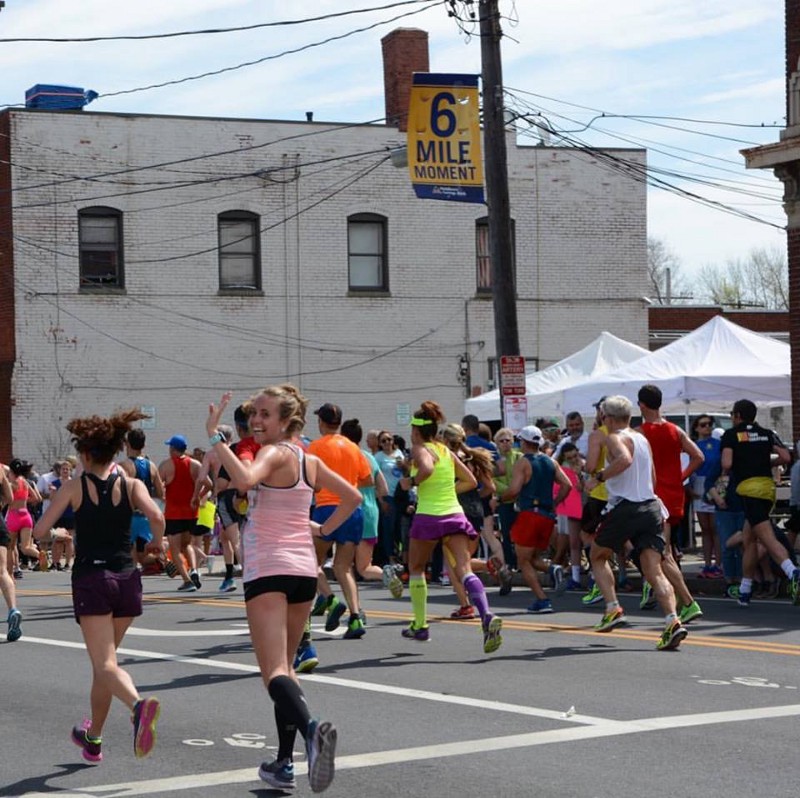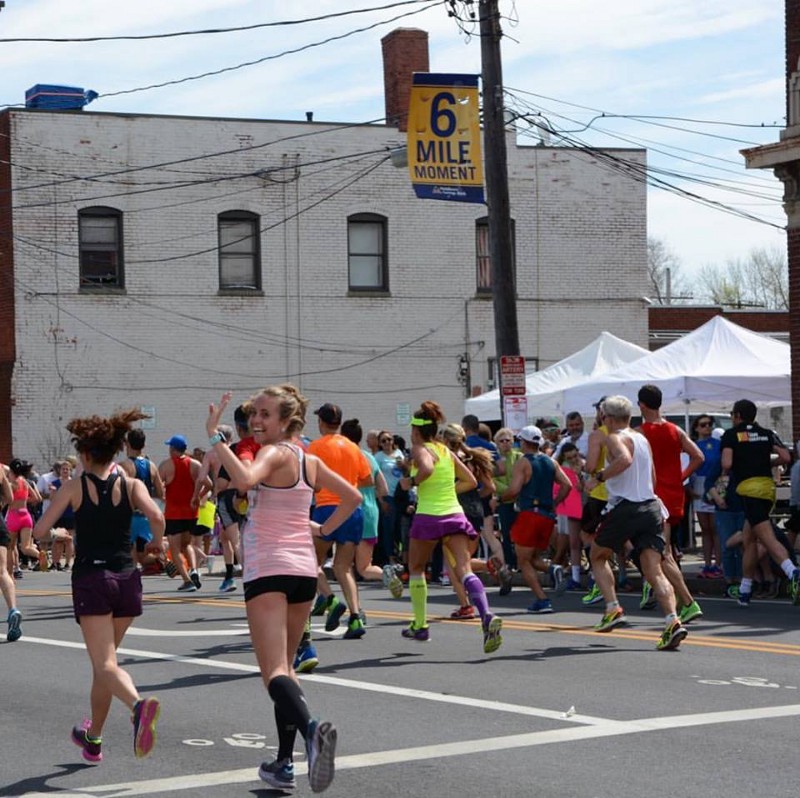This isn’t the Boston Marathon story I hoped I’d be telling, but that’s okay. It’s a Boston Marathon story, and that in itself, is a privilege.
This time four years ago my collegiate running career was coming to a close. I was unhappy, tired, and despised running. As I walked across campus one picture perfect April afternoon, my phone rang. It was my mom:
“I’m registering for the Wineglass Marathon, should I sign you up?”
Is this women insane, I thought, “Umm yeah?”, I answered. I didn’t know it then, but that phone call would change my life.
I was an 800m runner with a lifetime long-run high of 12.5 miles. I had no business training for a marathon so soon out of college. I wasn’t on good terms with the sport of running at the time. But I went for it.
With some loose guidance from my assistant coach, I began to train. Things were going well, but I developed a familiar pain in early August and headed to the doctor to confirm my fear: stress fracture number two.
By the time the October race arrived I’d been running again for two weeks. I’d logged about 30 miles since August and the longest run of my life was still shorter than a half marathon. But I decided to try, thinking it couldn’t possibly be that hard. I didn’t realize that you should drink water and take nutrition during a marathon, so I had some intense cramping in the last mile. Despite that, I finished. After a brief “never again” period, I decided a second marathon would be in my future.
As I trained for number two, the 2014 Marine Corps Marathon (MCM), I decided that maybe I could qualify for Boston, and that became my goal. To my surprise, I did and, as I set my sights on Boston, I set a new goal: run five marathons by thirty. Boston 2016 was marathon number three and despite brutal temps and an injury, it gave me a personal record (PR) and another Boston qualifying time (BQ). I definitely caught the marathon bug. I spent the summer recovering with cross-training and physical therapy, before taking on MCM a second time, just a month back into running. After completing that run on no training, in just shy of a BQ, I looked back on the first marathon and found it hard to believe I even finished. After that race, I realized Boston 2017 would be marathon number five and I needed a new goal: run five Boston Marathons by thirty.
Approaching Marathon Monday, I had a few goals: first and foremost, get to Hopkinton healthy; second, run a BQ; third, PR.
As I hydrated and stretched in Athlete’s Village, I felt confident and prepared. I felt the satisfaction of achieving goal number one (stay healthy) and believed I would meet goal’s two and three without a doubt. As the journey to Boston began, my legs felt fresh, I was hitting my goal pace, and everything seemed to be running smoothly.

Running smoothly
By mile nine, everything changed.
Boston is notorious for its quad-destroying downhills. My quads weren’t toast until mile twenty-three last year; this was another story. My quads felt like bricks. As I remained positive, repeating “you got this” over and over again in my mind, the pain grew. By mile ten I did something I had never considered an option, I started walking. At first I didn’t walk much, and I managed to get through the half still on pace for both a BQ and a (teeny tiny) PR, but no matter how much positive self-talk I tried, my legs were giving in.
If it were a training run, I would’ve stopped and tried again the next day, if it were any other race, I may have dropped out. But this was Boston, and no matter how daunting the task at hand seemed, I had to get to that finish line. As running became harder and I began to walk more, I realized both a BQ and a PR were out of the question and that also meant my goal of five Boston Marathon’s by thirty would be more difficult than expected. I allowed myself a mile or so of disappointment before forcing myself to accept what was happening and make the best of it. I was running the goddamn Boston Marathon after all.
For the next eleven miles, I struggled like I’ve never struggled before.
Through the struggle I learned so much. Around the half, a man tapped my back and said, “let’s go, aid station to aid station”, he told me he’d be doing the same and that he wasn’t going to pull ahead. We chatted and shuffled side by side for a while until drifting. Glancing around in the last couple of miles, he was still nearby, run-walking his way to the finish just like me, and lots of others around us. I learned that there is no shame in walking.
Twenty-six miles is a lot of miles, it doesn’t really matter how you get there.
I had something pulling me to mile eighteen.
As I approached mile eighteen I thought, just get to the November Project cheer station and go from there. Finally, I heard them, and I saw my dear friend Mel. I ran into her arms, hugged her, told her how dreadful I was feeling, and cried. She gave me a bit of life back, telling me I was strong and that she was proud. The rest of the cheer squad, complete strangers, offered their strength, as well. I can’t count how many strangers from mile eighteen on referred to me as “NP” and offered seriously inspiring encouragement. A short haired red head looked me in the eyes and said, “let’s go NP, I believe in you!” She didn’t know me, but I could tell she meant it and that gave me the courage to believe in myself.
Those who care about me the most are proud whether I run a three hour marathon or a five hour marathon.
A few miles after sobbing on Mel’s shoulder, I spotted my mom and my boyfriend, Tyler, for the third time on the course. They were yelling encouraging words and snapping photos. I ran to them and repeated the hug and cry I shared with Mel. They told me they loved me, they were proud of me, and I was amazing because I was going to finish. I thanked them, told them I loved them and hobbled away. That’s when I knew I wouldn’t quit. In that moment I recognized that those who care about me the most are proud whether I run a three hour marathon or a five hour marathon. All I needed to do was cross that finish line.

Incredibly thankful for the support of this wonderful man.
I continued my walk-run-hobble and before I knew it I was at mile twenty-five. I tried to run the last one point two miles, but my legs said “no.” I was walking with about three-quarters of a mile to go, preparing myself to start running again and not stop until I crossed the finish line, when a woman put her arm around me and said “come on, we’re almost there”. She pushed me forward, forcing me to run, and I knew I couldn’t let her down. I began trotting, painful baby steps; as we turned right onto Hereford my stride began to open up, until I reached Boylston and for the first time since the half, I was actually running. With each step my quads screamed at me to stop, but I knew I had to give it everything and cross that finish line running. If not for myself, for all the beautiful people supporting me along the way.
I experienced the strength and the community of Boston in a way I hadn’t the year before.
In the finishing shoot I felt terrible, my knees threatened to buckle, dizziness faded in and out, I fought against my gag reflex, but I was done. I’d finished the Boston Marathon again, and I’d run my fifth marathon. Despite the disappointment I couldn’t help but feel, I felt a new and overwhelming appreciation for the Boston Marathon. I experienced the strength and the community of Boston in a way I hadn’t the year before. I thought it humbled me the first time, but I had no idea. I suddenly felt an immense respect for the distance and I understood, for the first time, why people spend years working to qualify for magical race.
I may have not achieved all my goals but I gained something so much more important, a true appreciate for the Boston Marathon, one of the most spectacular events in the world.
Congratulations to all the finishers, from first to last. I am honored to have shared the streets of Boston with you. Thank you from the bottom of my heart to all the volunteers and all of my supporters.
Let's Go!
Coaching for Runners
Work with our coaches for a personalized training plan that takes into account every aspect of your life - from season to traveling to terrain.
Learn More
Workshops for Teams
Book a workshop to help shift team cultures and coach attitudes to provide a healthier environment and more competitive athletes.
